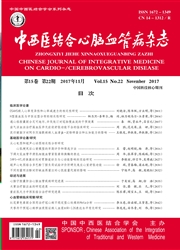

 中文摘要:
中文摘要:
目的探讨缺血性中风病痰热证病人发病72h内生物学指标NDKA、UFDP对中风病痰热证的诊断意义及对预后的评估价值。方法研究纳入50例符合标准的中风病痰热证病人,检测发病72h内生物学指标NDKA、UFDP的血清水平,采集发病14d的美国国立卫生研究院卒中量表(NIHSS)评分、痰热证评分及发病90d的Barthel指数(BI)评分。同时纳入30名正常人作为对照组。结果中风病发病72h内,病例组生物学指标UFDP与正常对照组比较有统计学意义(P=0.004),采用ROC曲线分析发现UFDP的AUC曲线下面积为0.608;生物学指标NDKA与NIHSS评分呈明显正相关(r=0.360,P=0.010),与痰热证评分相关性无统计学意义(r=0.200,P=0.163),与BI指数呈明显负相关(r=-0.297,P=0.045)。结论生物学指标UFDP对发病72h内中风病痰热证具有一定的诊断价值,生物学指标NDKA对中风病痰热证病人的近期神经功能缺损程度及远期功能残疾水平均具有一定的评估价值。
 英文摘要:
英文摘要:
Objective To identify the value of the two biological makers nucleoside diphosphate kinase A( NDKA) , ubiquitin fusion deg -radation protein( UFDP)for the the diagnosis and evaluation prognosis in acute ischemic stroke patients with phlegm heat syndrome.Methods Fifty patients with phlegm heat syndrome and 30 age and gender matched healthy subjects were included in thestudy. The serum NDKA, UFDP levels were measured by ELISA kits at within 3 days of onset, and NIHSS scores, phlegm heat syndrome scores were measured at day 14, BI scores were measured at day 90 after the onset.Results There was a significant difference in serum UFDP( P =0.004)between acute stroke patients within 3 days of onset and healthy controls.The ROC curve of UFDPfor the diagnosis of phlegm heat syndrome of traditional Chinese medicine( TCM)in acute ischemic stroke was 0.608. There was asignificantly positive correlation between the serum NDKA levels and NIHSS scores( r =0.360, P =0.010) , a significantly negativecorrelation between it and BI scores ( r = -0.297, P =0.045) , but a significant correlation was not found between the NDKA levelsand phlegm heat syndrome scores.Conclusion The serum UFDP concentration exhibit diagnostic value for the phlegm heat syndrome of TCM in patients with acute ischemic stroke, and the serum NDKA concentration within 3 days of onset exhibit evaluationvalue for recent nerve function defect degree and long term function disability levels in acute ischemic stroke patients with phlegmheat syndrome.
 同期刊论文项目
同期刊论文项目
 同项目期刊论文
同项目期刊论文
 期刊信息
期刊信息
